As an Amazon Associate KitchenwareSets.com earns from qualifying purchases.
7 Tiny Apartment Kitchen Ideas for Renters on a Budget
Is your tiny apartment kitchen feeling more like a cluttered closet than the heart of your home? You’re not alone. The daily struggle with limited counter space, dated cabinets you can’t change, and a general lack of storage can make cooking feel like a frustrating chore rather than a creative joy. It’s easy to scroll through beautiful kitchen makeovers online and feel like they’re completely out of reach for a renter on a budget.
When you’re bound by a lease agreement and tight finances, the dream of a functional, inviting kitchen can seem impossible. The fear of losing your security deposit prevents any major changes, and the sheer lack of square footage makes every appliance and utensil feel like it’s in the way. You crave a space that’s not only efficient for meal prep but also a place you genuinely enjoy spending time in, a kitchen that reflects your personal style.
Living in a small apartment doesn’t mean you have to settle for a kitchen you dislike. By focusing on vertical storage, clever non-permanent updates like peel-and-stick backsplashes, and smart decor swaps, you can create a beautiful, functional, and inviting kitchen on a budget without risking your security deposit.
Is Your Tiny Apartment Kitchen Feeling More Frustrating Than Functional?
Yes, a tiny apartment kitchen can often feel more frustrating than functional, but simple, non-permanent solutions can completely transform the space. As someone who has navigated the challenges of multiple rental kitchens, I know the struggle is real. But I also know that a few strategic, non-permanent changes can make you fall in love with your kitchen, no matter its size. The key is to shift your perspective from what you can’t change to what you can control, focusing on reversible, high-impact upgrades that add both personality and practicality.
7 Game-Changing Apartment Kitchen Ideas for Renters (Updated for 2025)
The most game-changing apartment kitchen ideas for renters are those that maximize space and add personal style without making permanent alterations. This curated list focuses on the most impactful, low-cost ideas specifically for renters. Each of these 7 ideas has been selected for its high impact and low commitment, ensuring you can create a space you love that’s 100% reversible when it’s time to move. From genius storage hacks to decorative upgrades that look expensive (but aren’t), these tips will make a significant difference in both the look and function of your kitchen.
1. Go Vertical: Embrace Open Shelving & Wall Racks
The best way to create more storage in a small kitchen is to utilize the empty vertical space on your walls. When floor and counter space are at a premium, looking up is the answer. Wall-mounted racks, floating shelves, and even simple under-cabinet hooks can dramatically increase your storage capacity, get clutter off your countertops, and make your kitchen feel larger and more organized.
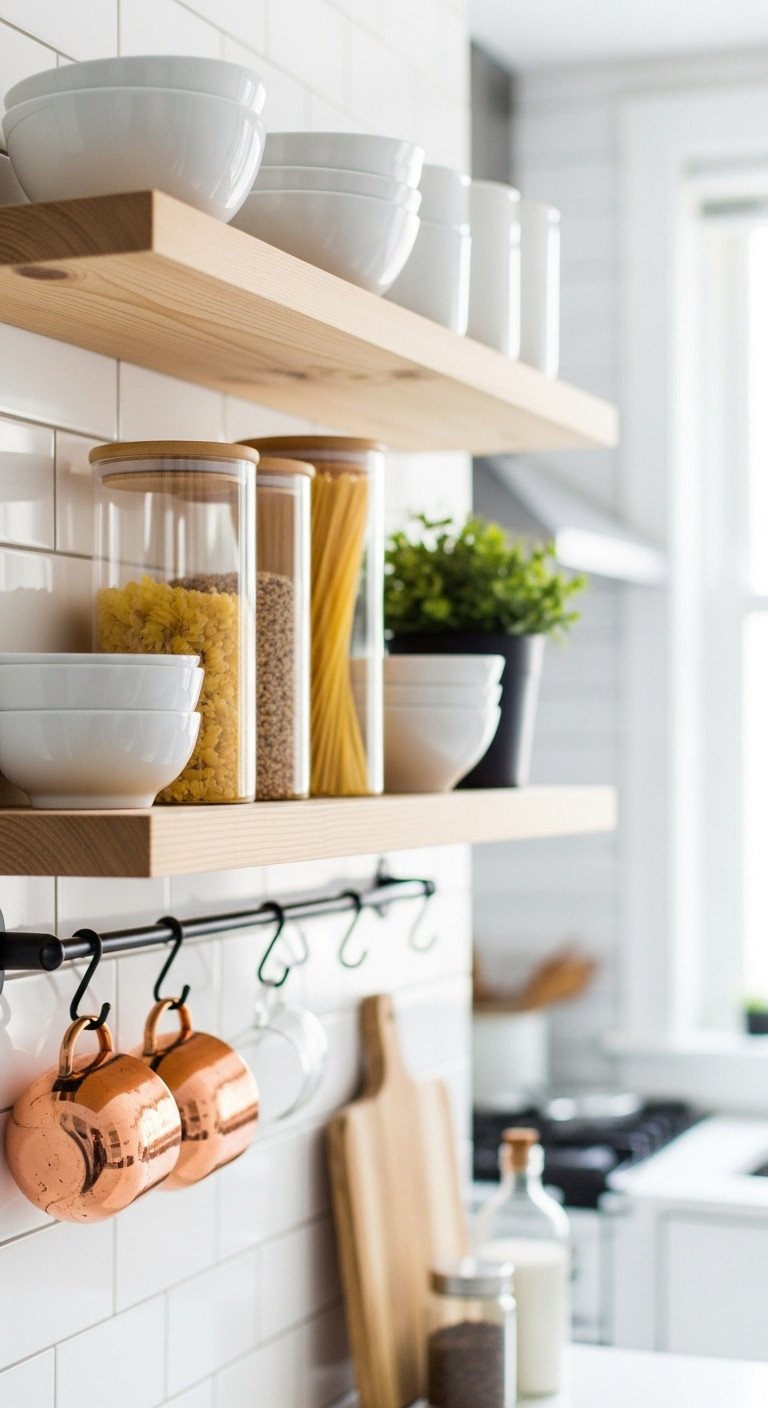
Pin this vertical storage hack for later!
- Materials Needed: Floating shelves, wall-mounted pot rack, measuring tape, level, pencil, stud finder (optional but recommended), screwdriver.
- Step-by-Step Directions:
- De-Door Your Cabinets: For the ultimate no-holes approach, carefully remove the doors from one or two upper cabinets. Store the doors and hardware safely in a labeled bag to reattach when you move out. This instantly creates an open-shelf look.
- Hang a Pot Rack: Free up precious cabinet space by hanging your most-used pots and pans. Look for a sturdy wall-mounted pot and pan rack that can be secured with a few screws. Place it on an open wall near your stove for easy access.
- Install Floating Shelves: If your lease allows for small screw holes, install one or two floating shelves. Mount them higher up the wall to draw the eye upward and make the room feel taller. Use them to store everyday dishes or display decor.
- Add Under-Cabinet Racks: Maximize the space beneath your existing cabinets by installing simple screw-in racks for mugs, wine glasses, or paper towels.
Pro-Tip: Before you hang anything heavy, use a stud finder. If you can’t find a stud, make sure to use wall anchors that are rated for the weight you plan to hang to prevent damage to the drywall.
2. Get Rolling with Smart Mobile Storage
You can add flexible storage and prep space by introducing a slim, mobile kitchen cart. Those awkward, narrow gaps—often next to the fridge or stove—are wasted real estate in a tiny kitchen. A rolling utility cart transforms these unused inches into a storage powerhouse for spices, oils, or produce, and it can be easily moved wherever you need it most.
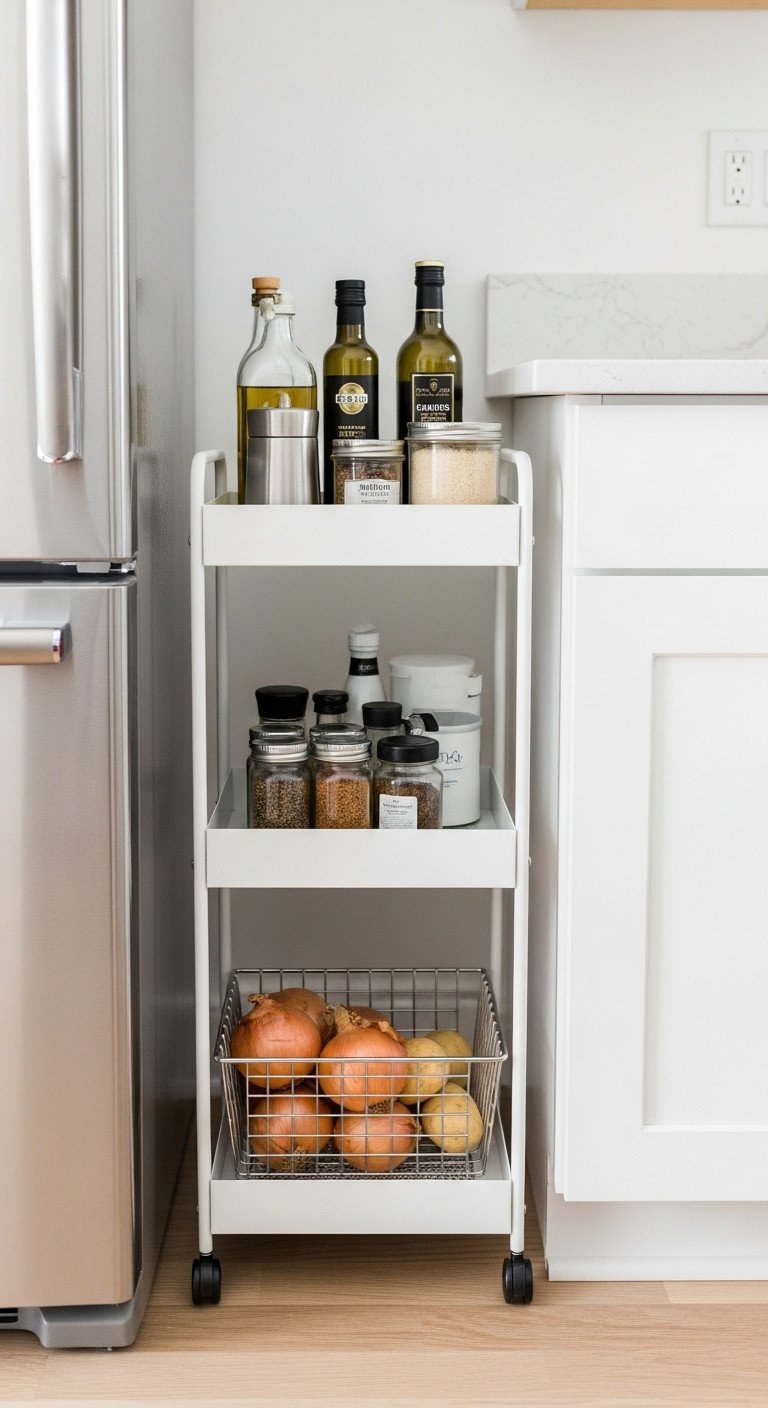
Love this idea? Save it to your ‘Small Space Solutions’ board!
- Materials Needed: A pre-assembled or easy-to-assemble slim rolling cart.
- Step-by-Step Directions:
- Measure Your Gap: Identify an unused narrow space in your kitchen, often found next to the refrigerator or oven. Measure its width carefully.
- Find the Perfect Cart: Search for a slim rolling storage cart that is slightly narrower than your measured gap. Look for multi-tiered models to maximize storage potential.
- Organize by Use: Dedicate each tier to a specific category. For example, use the top for frequently used cooking oils and vinegars, the middle for spices, and the bottom for root vegetables or cleaning supplies.
- Use as Extra Prep Space: If you have a bit more room, a slightly larger kitchen cart with a butcher block top can double as a small, mobile island, giving you much-needed extra counter space that can be moved out of the way.
Lesson Learned: Opt for a cart with locking wheels. This is a game-changer for stability when you’re using it as a prep surface for chopping vegetables.
3. Fake a High-End Look with a Peel-and-Stick Backsplash
The easiest and most affordable way to cover a dated backsplash is by applying high-quality, removable peel-and-stick tiles. This renter-friendly DIY project requires no grout, no special tools, and no long-term commitment. In just a couple of hours, you can completely change the personality of your kitchen, adding color, pattern, and a clean, modern finish that looks surprisingly like real tile.
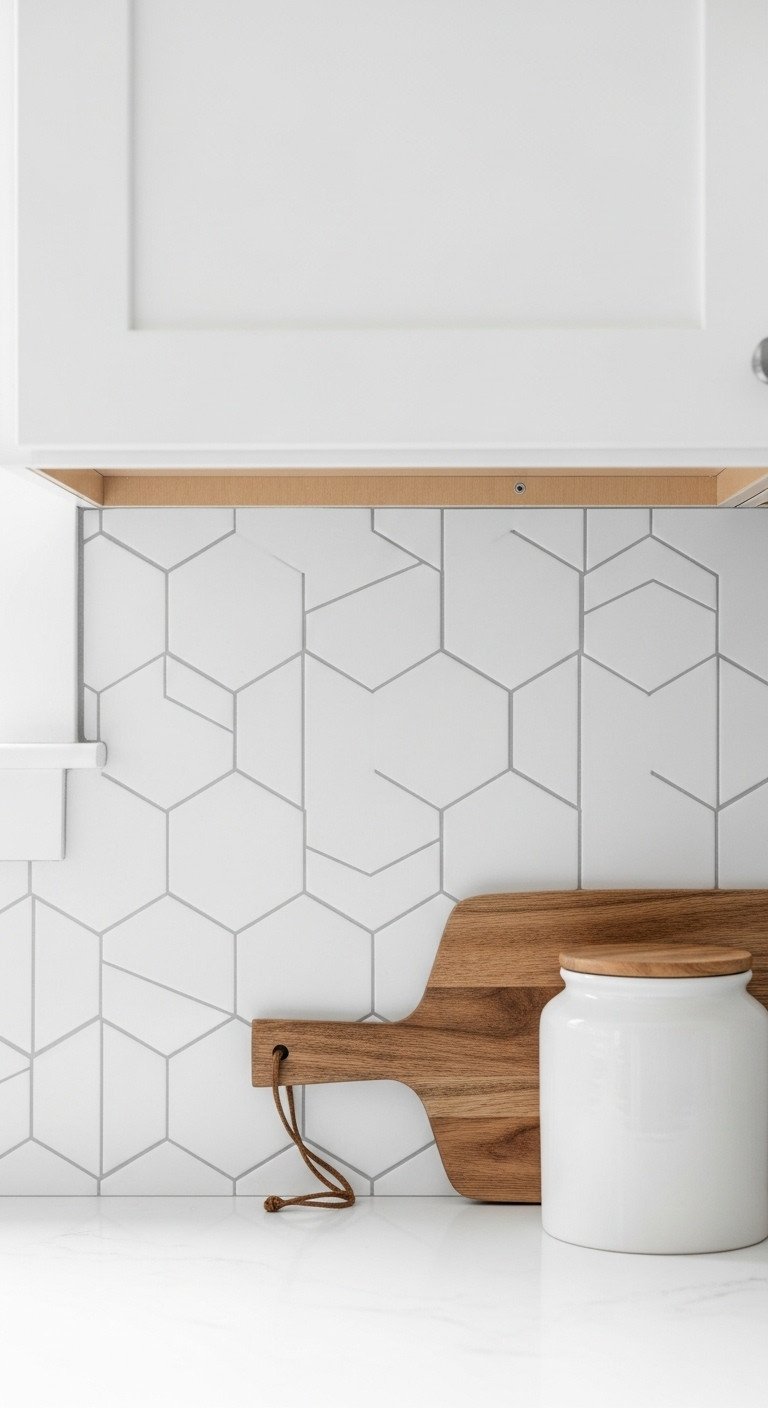
Save this renter-friendly makeover to your DIY board!
- Materials Needed: High-quality peel-and-stick tiles, degreasing cleaner, cloth, measuring tape, utility knife or sharp scissors, level.
- Step-by-Step Directions:
- Prep the Wall: This is the most important step. Thoroughly clean the existing wall or backsplash with a degreasing cleaner to remove any kitchen grime. The tiles will not adhere properly to a greasy surface. Let it dry completely.
- Measure and Plan: Measure the area you want to cover. It’s helpful to lay out your tiles on the floor first to plan your pattern and cuts, especially around outlets.
- Start in a Corner: Peel the backing off your first tile and carefully apply it to the wall, starting in a corner and using a level to ensure it’s straight. Press firmly from the center outwards to remove air bubbles.
- Overlap and Cut: Overlap the tiles according to the manufacturer’s instructions to create a seamless, grout-like effect. When you reach an outlet or corner, use a sharp utility knife to carefully trim the tile to fit. Choose quality peel and stick kitchen backsplash tiles that are specifically designed to be heat and humidity-resistant.
Pro-Tip: Before peeling the backing, do a “dry fit” of the first few tiles to ensure your alignment is correct. It’s much easier to adjust a tile before the adhesive touches the wall.
4. Brighten Up with Strategic (and Removable) Lighting
You can easily improve poor kitchen lighting without an electrician by installing plug-in or battery-operated under-cabinet LED lights. Many rental kitchens suffer from a single, harsh overhead light that casts shadows on your countertops, making food prep difficult. Stick-on LED strips or puck lights are a brilliant solution that instantly brightens your workspace, adds a warm ambiance, and makes the whole kitchen feel more high-end.
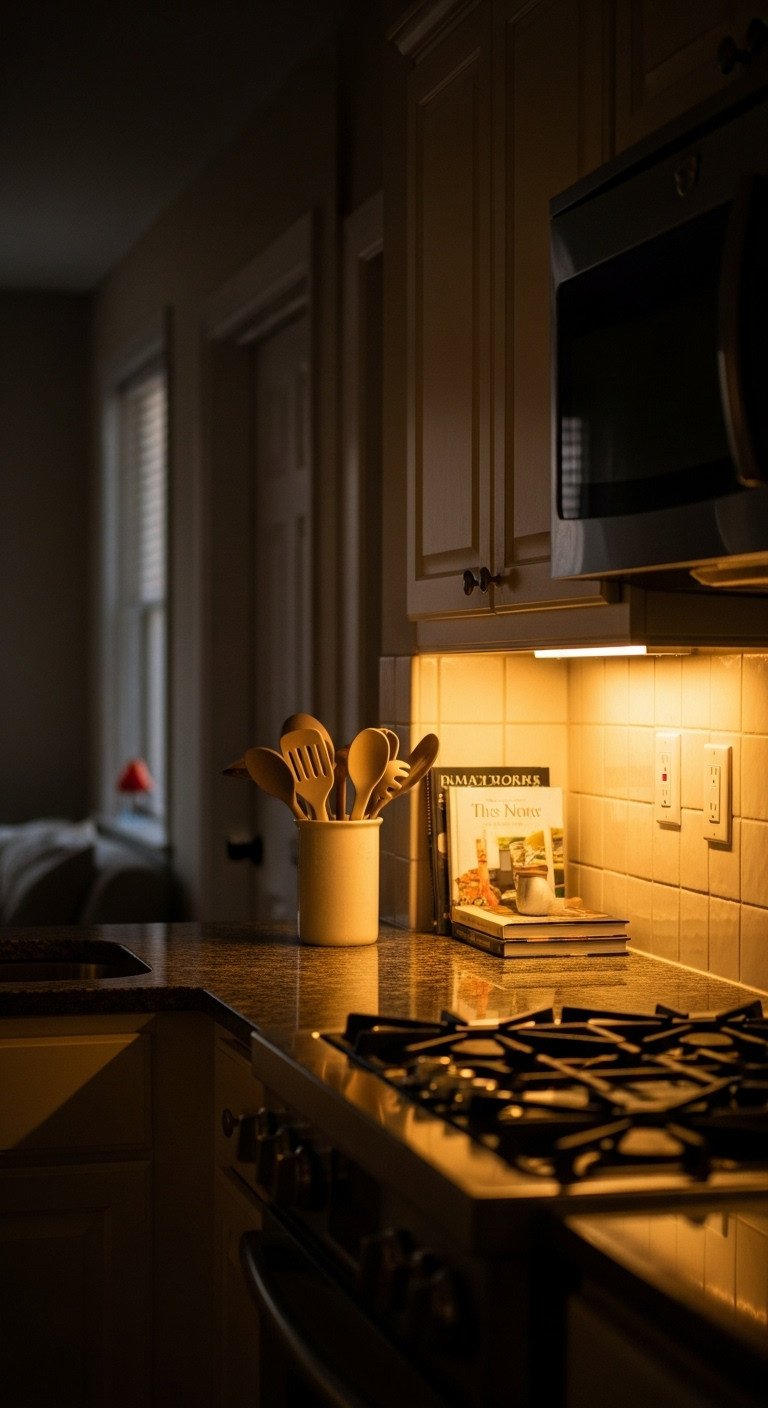
Pin this bright idea for your kitchen!
- Materials Needed: A plug-in or battery-operated under-cabinet LED lighting kit, cleaning cloth.
- Step-by-Step Directions:
- Choose Your Light: For ultimate simplicity, select an under cabinet LED lighting kit that is either battery-operated with an adhesive backing or a plug-in strip. This requires no wiring.
- Clean the Surface: Wipe the underside of your cabinets thoroughly to ensure the adhesive will stick properly.
- Stick and Illuminate: Peel the backing from the light strips or puck lights and press them firmly into place under the cabinets. Position them closer to the front of the cabinet to illuminate your workspace, not just the back wall.
- Hide the Cord: If using a plug-in version, use small, removable adhesive cord clips to run the wire neatly along the back corner of the countertop to the nearest outlet.
Pro-Tip: Look for LED kits that come with a remote control or a dimming feature. This allows you to adjust the brightness for task cooking or for a soft ambient glow in the evening.
5. Swap Out Hardware for a High-Impact, Low-Cost Upgrade
The quickest and most reversible way to update kitchen cabinets is to replace the existing knobs and pulls with new, stylish hardware. This simple swap takes less than an hour but has a massive visual impact. It can instantly elevate builder-grade cabinets, making them look more modern, custom, and in line with your personal aesthetic—all while being completely reversible when you move out.
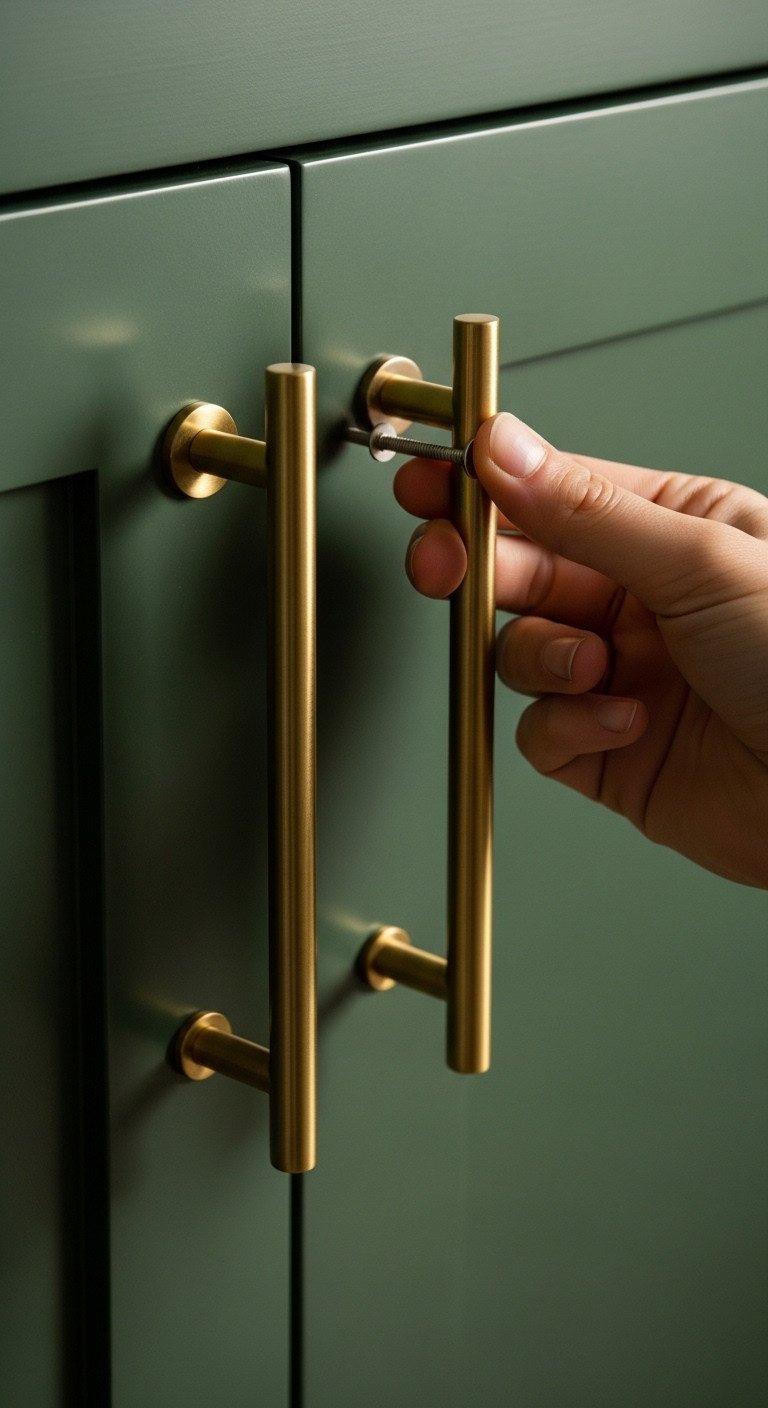
Save this easy upgrade to your ‘Future Home’ board!
- Materials Needed: New cabinet knobs or pulls, screwdriver, small ziplock bag.
- Step-by-Step Directions:
- Count and Measure: Count how many knobs and pulls you need to replace. If you’re replacing pulls (handles with two screws), measure the distance between the center of each screw hole. This is your “center-to-center” measurement, which is crucial for buying replacements.
- Save the Originals: Carefully unscrew the old hardware. Place all the original knobs, pulls, and their screws into a labeled ziplock bag and store it in a drawer. This is the key to getting your security deposit back!
- Select Your Style: Choose new hardware that matches the existing holes. Simple round knobs or modern brushed brass cabinet pulls can instantly make builder-grade cabinets look custom and chic.
- Install the New Bling: Simply screw the new hardware into the existing holes. This entire process can take less than 30 minutes and completely changes the feel of your kitchen.
Lesson Learned: Don’t throw away the original screws! Sometimes the screws that come with new hardware are a different length, and the original ones will provide the perfect fit for your cabinet thickness.
6. Magically Create More Counter Space
You can instantly create more prep space by using a large wooden cutting board or a dedicated stove top cover. When your stove isn’t in use (and is completely cool), its surface is just wasted space. A stove cover, sometimes called a noodle board, transforms this area into a stable, usable surface, effectively doubling your available counter space for chopping, mixing, or simply setting things down.
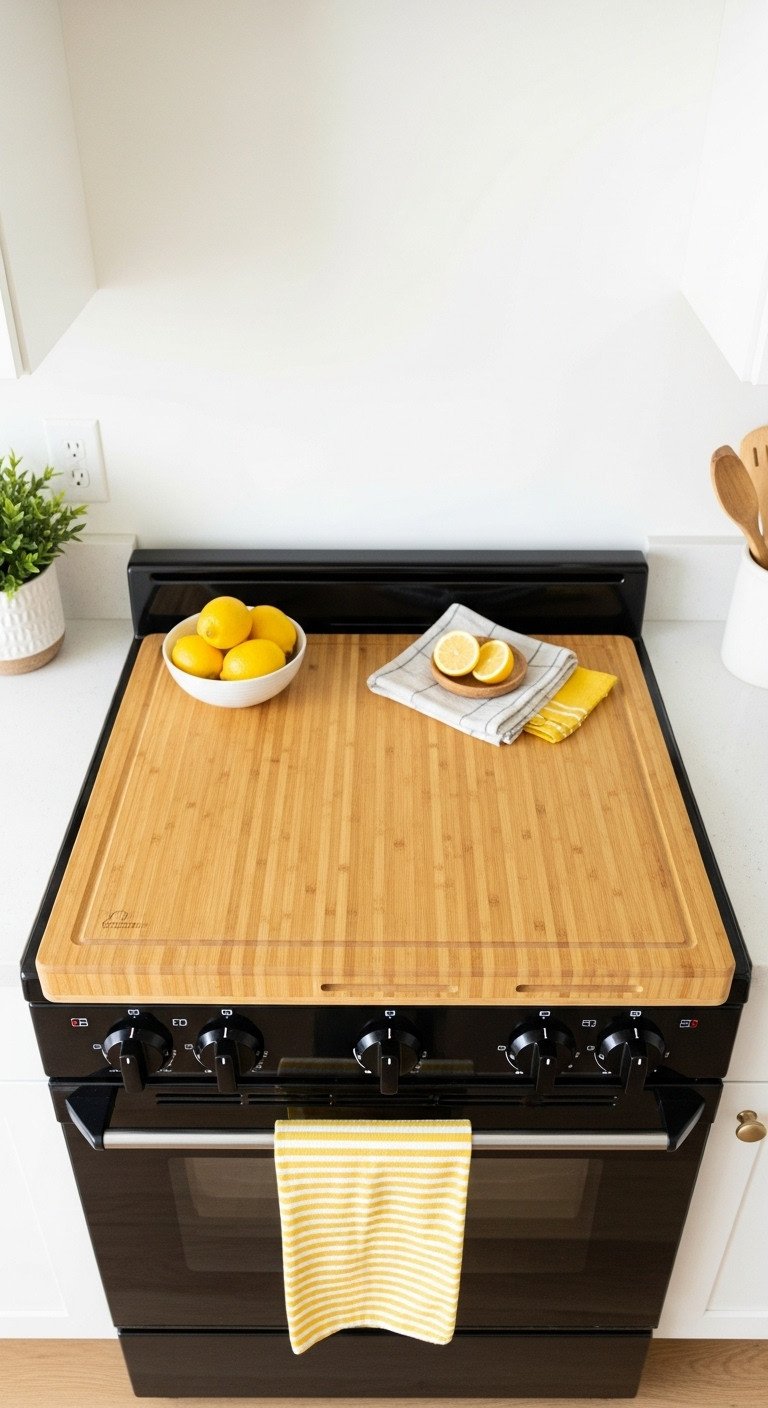
Pin this genius space-saving hack!
- Materials Needed: A stove top cover or a large, sturdy cutting board that fits your stove’s dimensions.
- Step-by-Step Directions:
- Ensure Safety First: This hack is ONLY for when your stove and oven are completely off and cool to the touch. Never place a cover on a hot surface.
- Measure Your Stove: Measure the width and depth of your stovetop to find a cover that will fit securely over the burners without sliding.
- Choose Your Cover: You can buy a dedicated stove top cover, sometimes called a “noodle board,” which can be found in wood, metal, or glass. Alternatively, a large, flat wooden cutting board can serve the same purpose.
- Enjoy the Extra Space: Place the cover over your cool burners to instantly gain several square feet of usable space. It’s perfect for placing mixing bowls while you prep ingredients, setting down groceries, or even as a serving surface during a party.
Pro-Tip: Look for a stove cover with small rubber feet on the bottom. This prevents it from scratching your stovetop and helps it stay securely in place.
7. Install a Flexible Wall-Mounted Dining Nook
To create an eat-in space in a kitchen with no floor space, install a wall-mounted drop-leaf table. This brilliant piece of furniture provides a sturdy surface for dining or working when you need it, and it folds down nearly flat against the wall when you don’t. It’s the perfect solution for creating a functional breakfast bar in a narrow galley kitchen or a tiny studio apartment.
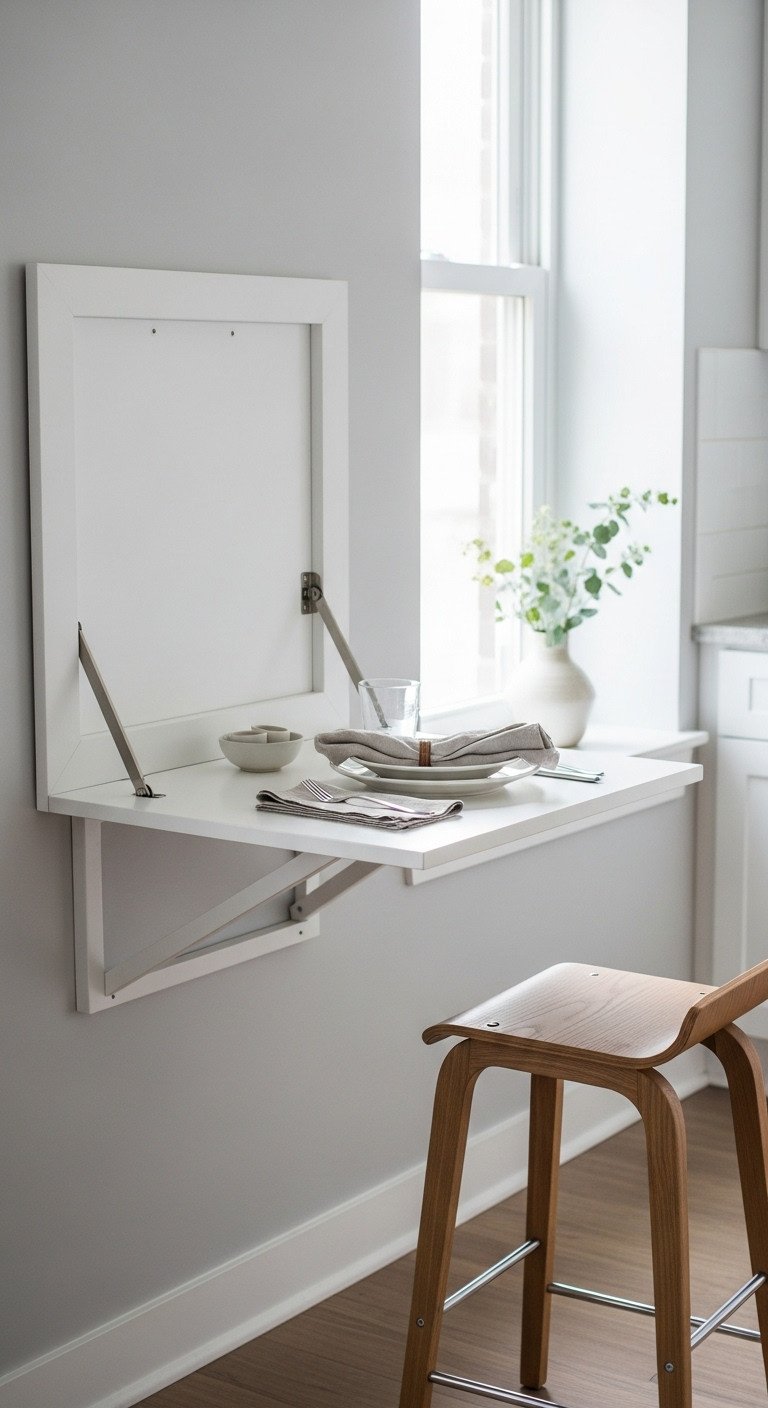
Save this tiny dining solution to your ‘Apartment Goals’ board!
- Materials Needed: Wall-mounted drop-leaf table kit, drill, level, stud finder, pencil.
- Step-by-Step Directions:
- Get Permission: Since this requires drilling into the wall, it’s best to check with your landlord first. Explain that it’s a minimal, space-enhancing feature and that you will patch the holes upon moving out.
- Find the Studs: Locate a clear section of wall. Use a stud finder to mark the location of the wall studs. Attaching the table to studs is essential for it to be secure enough to use.
- Mount the Table: Following the manufacturer’s instructions, use a drill to securely attach the wall-mounted drop-leaf table to the wall, making sure it’s perfectly level. These tables are designed to be sturdy when up and fold down flat against the wall when not in use.
- Add Seating: Pair the table with one or two slim, stackable stools that can be easily tucked away in a corner or closet when the table is folded down.
Lesson Learned: Measure twice, drill once! Before drilling, hold the table up to the wall in both the folded and unfolded positions to ensure it has enough clearance from doorways, cabinets, and appliances.
https://www.youtube.com/watch?v=PoZtddZl8xI
Key Takeaways: Your Quick Guide to a Better Rental Kitchen
To quickly improve your rental kitchen, the core principles are simple and effective. Remembering these key strategies will empower you to make smart, impactful choices that enhance both the beauty and utility of your small space.
* Think Vertically: Use walls for storage with shelves and racks to free up counters.
* Embrace “Temporary”: Peel-and-stick products for backsplashes and floors offer huge visual impact with zero commitment.
* Small Swaps, Big Impact: Never underestimate the power of new cabinet hardware or better lighting.
* Prioritize Function: Choose items that are flexible and multi-purpose, like rolling carts or stove covers, to maximize a small footprint.
People Also Ask About Apartment Kitchen Ideas
Navigating the world of rental kitchen upgrades can bring up a lot of questions. Here are direct answers to some of the most common queries people have when looking for apartment kitchen ideas.
How can I make my apartment kitchen look nice on a budget?
To make an apartment kitchen look nice on a budget, focus on low-cost, high-impact changes. Swap out dated cabinet hardware for modern pulls, apply a stylish peel-and-stick backsplash, and add warm under-cabinet lighting. Decluttering countertops and adding a small plant or a colorful rug can also instantly make the space feel more inviting and personalized.
What is the best kitchen layout for a small apartment?
The one-wall kitchen layout is often the best for small apartments. This design places all cabinets, countertops, and appliances along a single wall, maximizing open floor space. For slightly larger but still small spaces, a galley kitchen (two parallel walls) is also highly efficient for cooking workflow.
How can I get more counter space in my small kitchen?
You can get more counter space by using an over-the-sink cutting board or dish rack. A wooden stove top cover (or noodle board) can also be placed over cool burners to create a large prep area. Additionally, a small rolling kitchen cart can act as a mobile island for extra workspace when you need it.
Final Thoughts
Transforming your small rental kitchen doesn’t require a huge budget or a friendly landlord willing to renovate. It’s about making smart, strategic choices that add function and reflect your personality. A rental kitchen doesn’t have to be a source of frustration; it can be a space you truly enjoy. Start with just one small project from this list—like swapping out cabinet knobs or adding under-cabinet lights—and see what a difference it can make in your daily life.
Which of these ideas are you most excited to try in your own kitchen? Let us know in the comments below
Last update on 2025-11-14 at 20:51 / Affiliate links / Images from Amazon Product Advertising API
